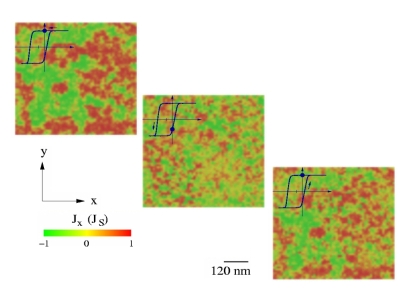Exchange bias and pinning effects in AF/FM thin layers
| The mechanism for exchange bias and training for antiferromagnet/ferromagnet bilayers with fully compensated
interfaces is studied by micromagnetic simulations together with experimental investigations.The bias shift of hysteresis
and coercivity are controlled by domain-wall formation between exchange-coupled grains in the antiferromagnet. The finite
element micromagnetic calculation shows that a weak exchange interaction between randomly oriented antiferromagnetic grains
and spin-flop coupling at a perfectly compensated interface are sufficient to create shifted hysteresis loops characteristic
of exchange bias. Unlike previous partial wall models, the energy associated with the unidirectional anisotropy is stored
in lateral domain walls located between antiferromagnetic grains. We also show that the mechanism leads naturally to a
training effect during magnetization loop cycling.
Exchange bias effect of AM/FM bilayers ar already well know for more than forty years. Most recently, possible device applications in magnetic field sensors, recording heads, MRAM etc. have renewed interest in exchange bias and highlighted the need for a quantitative understanding of the phenomenon. Some of the more commonly studied materials use sputtered IrMn and MnFe antiferromagnetic films. A successful model forexchange bias should therefore be able to describe loop shifts and coercivity for polycrystalline films. Additionally, the theory should also be able to describe effects of well-defined interfaces between the ferromagnet and antiferromagnet such as what one might expect for systems using CoO or NiO. A particular challenge is to explain exchange bias in the case of perfectly compensated interfaces, and also to understand the sometimes observed insensitivity of measured bias to supposed interface structures defects. D. Suess, M. Kirschner, T. Schrefl, J. Fidler, R. L. Stamps, and J.-V. Kim, |
Domain structure in the antiferromagnetic IrMn layer
Fig.1: Numerical micromagnetic simulation of the transient states of the magnetization reversal in a AF (IrMn) and FM (NiFe) biased bilayer. State after field cooling. |
Contact: J. Fidler, D. Suess |


